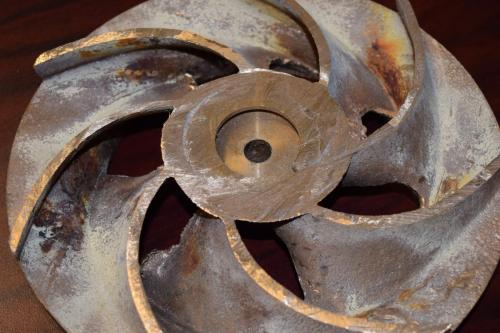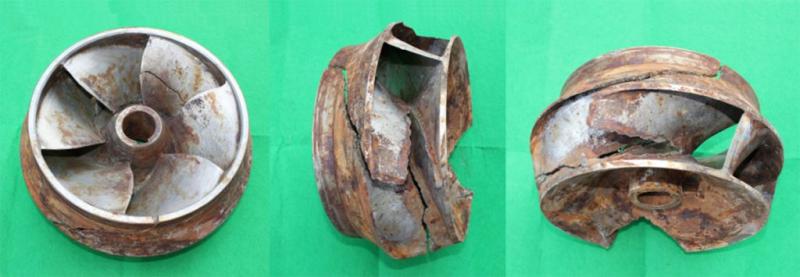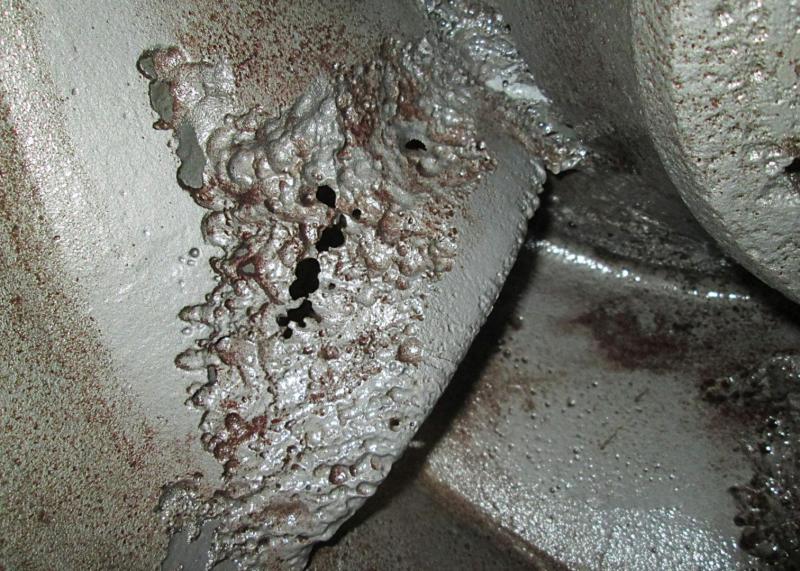Kavitasi Pompa

Kavitasi pompa adalah fenomena yang terjadi ketika tekanan di dalam pompa turun hingga berada di bawah tekanan uap cairan yang dipompa, sehingga menyebabkan cairan tersebut berubah menjadi gas (menguap) dan membentuk gelembung-gelembung uap. Gelembung ini kemudian akan terbawa ke bagian tekanan yang lebih tinggi, di mana gelembung-gelembung tersebut akan pecah (implosion), menghasilkan gelombang kejut yang dapat merusak komponen pompa seperti impeler atau casing.
Penyebab Utama Kavitasi:
- Tekanan masuk yang terlalu rendah (NPSH Available rendah)
Jika tekanan cairan yang masuk ke pompa (Net Positive Suction Head Available/NPSHa) lebih kecil dari tekanan yang diperlukan oleh pompa (Net Positive Suction Head Required/NPSHr), maka kavitasi bisa terjadi. - Temperatur cairan terlalu tinggi
Cairan yang terlalu panas cenderung memiliki tekanan uap yang lebih tinggi, sehingga lebih mudah menguap. - Kecepatan aliran yang terlalu tinggi
Aliran cairan yang terlalu cepat di area tertentu (seperti inlet pompa) dapat menurunkan tekanan secara lokal, sehingga memicu kavitasi. - Desain sistem atau pompa yang tidak optimal
- Pemilihan pompa yang tidak sesuai dengan aplikasi.
- Pipa suction terlalu panjang atau terlalu kecil, sehingga menimbulkan kerugian tekanan yang besar.
Dampak Kavitasi:
- Kerusakan fisik pada pompa
- Gelembung yang pecah menghasilkan tekanan tinggi yang dapat menyebabkan erosi pada permukaan impeler atau casing.
- Penurunan efisiensi pompa
- Kavitasi mengurangi kapasitas pompa, tekanan, dan efisiensinya.
- Getaran dan kebisingan
- Kavitasi sering menghasilkan getaran dan suara berisik (seperti "gravel" di dalam pompa).
- Umur komponen pompa lebih pendek
- Akumulasi kerusakan dari kavitasi memperpendek masa pakai pompa.
Cara Mengatasi dan Mencegah Kavitasi:
- Meningkatkan NPSHa
- Kurangi panjang atau hambatan pada pipa suction.
- Pastikan diameter pipa suction cukup besar.
- Tempatkan pompa lebih dekat ke sumber cairan (minimalkan ketinggian hisap).
- Memilih pompa yang sesuai
- Gunakan pompa dengan NPSHr yang lebih rendah daripada NPSHa sistem.
- Pertimbangkan desain impeler anti-kavitasi jika sering digunakan untuk cairan mendekati titik didih.
- Menurunkan temperatur cairan
- Jika memungkinkan, gunakan pendinginan untuk menurunkan suhu cairan.
- Mengurangi kecepatan pompa
- Turunkan RPM pompa untuk mengurangi risiko kavitasi.
- Perawatan dan inspeksi rutin
- Pastikan tidak ada penyumbatan atau kebocoran udara di sisi suction

What Causes a Centrifugal Pump to Cavitate?
Centrifugal pump cavitation may be due to various factors, some of which include:
- Insufficient NPSH (Net Positive Suction Head): The pump’s NPSH is lower than the NPSHA (Net Positive Suction Head Available) of the liquid being pumped.
- Poor Pump Design: A poorly designed pump with a low suction-specific speed can lead to cavitation.
- Viscosity Changes: Changes in the viscosity of the liquid being pumped can cause cavitation, especially in high-viscosity liquids.
- Piping System: The piping system can also cause cavitation. For example, a long suction pipe with many elbows can reduce the NPSHA, eventually leading to cavitation.

Types of Cavitation: Suction and Discharge
The two types of cavitation are suction cavitation and discharge cavitation.
Suction Cavitation: Suction cavitation occurs when the centrifugal pump is subjected to low pressure or high vacuum conditions. It is characterized by the impeller having multiple pitting, which makes it resemble a sponge.
Some of the possible causes of suction cavitation include:
- The pump running too far right on the pump curve
- Clogged suction pipe
- Poor suction conditions
- High inlet fluid velocity
- Poor pipe design
Discharge Cavitation: Discharge cavitation occurs when the centrifugal pump’s pressure is too high or loses 90% of its efficiency. Under this condition, the fluid cannot easily flow out of the pump. Instead, it moves inside the working chamber at high speeds, causing cavities to form. The easiest way to identify discharge cavitation is to check the impeller for pitting around the outer edges.
Some of the possible causes of discharge cavitation include:
- The pump running too far left (below Minimum Continuous Stable Flow) on the pump curve
- Clogged discharge pipes or filters
- Poor pipework design
How To Prevent Centrifugal Pump Cavitation
- Pump Selection: The most effective way to prevent cavitation is by selecting the right pump for the application. Cavitation is more likely to occur when the pump head falls or as capacity increases. Choosing the correct pump helps you maintain a positive margin of NPSHa to NPSHr. Ensure the pressure at the pump inlet is at least 10% greater than the pump’s NPSHr.
- Remove Bends and Valves: Bends and valves create restrictions in the flow, causing an increase in fluid velocity and a drop in pressure. This drop in pressure can cause the fluid to reach its vapor pressure and form vapor bubbles, which can collapse and cause cavitation. By reducing the number of bends and valves, the fluid flow is smoother and less restricted, leading to a lower fluid velocity and less pressure drop.
- Maintenance: You also need to carry out regular maintenance on the pump to avoid cavitation. Check filters and strainers to see if they are blocked and unclog them. Assess the entire pump system design to ensure the flow rate is at optimum levels.
- Adjust Suction Pipe Length and Diameter: A long suction pipe can cause a significant pressure drop, leading to cavitation. Therefore, reducing the length can decrease the chances of cavitation. The diameter of the suction pipe affects the fluid velocity, and it can increase the likelihood of cavitation if it is too small. Ideally, ensure there is 12cm of straight pipe for every diameter of pump suction.
PT Renjana Multi Sinergi
Jl. Pemda Tigaraksa No.5,
Komplek Pergudangan Bizlink Citra Raya Blok O8 /20,
Sukamulya, Kec. Cikupa,Tangerang 15710, Banten.
Indonesia